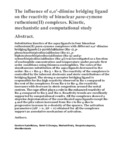The influence of α,α′-diimine bridging ligand on the reactivity of binuclear para-cymene ruthenium(II) complexes. Kinetic, mechanistic and computational study
Date
2021-01Author
Mutua, Gershom Kyalo
Onunga, Daniel O.
Sitati, Meshack
Jaganyi, Deogratius
Mambanda, Allen
Metadata
Show full item recordAbstract
Substitution kinetics of the aqua ligands in four binuclear ruthenium(II) para-cymene complexes with different α,α′-diimine bridging ligands [2-pyridylaldazine (Ru-1), p-phenylenebis(picoline)aldimine (Ru-2), p-biphenylenebis(picoline)aldimine (Ru-3) and p-xylenebis(picoline)aldimine (Ru-4)] was investigated as a function of nucleophile concentration and temperature under pseudo-first order conditions using thiourea nucleophiles. The rates of the simultaneous substitution of the aqua ligands decreased in the order: Ru-1 > Ru-4 > Ru-3 > Ru-2. The reactivity of the complexes is controlled by the inherent electronic and steric contributions of the bridging ligand. The strong π-acceptor bridging ligand is responsible for the high reactivity observed in Ru-1 compared to the rest of the complexes. From Ru-2 to Ru-4, the reactivity increases with decrease in steric congestion around the metal centres. The cage effect plays a role in the enhanced reactivity of Ru-4 compared to Ru-3 and Ru-2. Reactivity trends are excellently supported by computational results. All the complexes showed a stepwise deprotonation of the coordinated aqua ligands except Ru-4 and the pKa values increased from Ru-1 to Ru-4 due to progressive increase in σ-donicity of the spacers. The activation parameters (ΔH≠ > 0, ΔS≠ < 0) obtained for all the complexes support an associative mechanism of activation.
URI
https://doi.org/10.1016/j.ica.2020.119972https://www.sciencedirect.com/science/article/abs/pii/S0020169320311725
http://ir-library.mmust.ac.ke:8080/xmlui/handle/123456789/1927
Collections
- Gold Collection [989]

